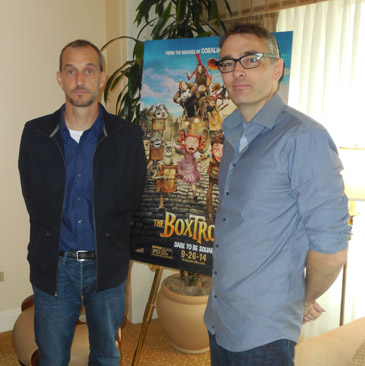CHICAGO – In anticipation of the scariest week of the year, HollywoodChicago.com launches its 2024 Movie Gifts series, which will suggest DVDs and collections for holiday giving.
Interview: Directors of ‘The Boxtrolls’ on Their Animated Life
CHICAGO – How do you interpret an odd British storybook called “Here Be Monsters!” into a mainstream animated film? By taking the main characters – called ‘The Boxtrolls’ – and putting them up front. Animation veterans and co-directors Graham Annable and Anthony Stacchi got the assignment, and deliver the goods.
Both creators have been around the animation block, but this is Annable’s first major animation directorial effort. He cut his teeth as a comic book artist and video game director, and was a story artist on the recent “ParaNorman.” Stacchi was previously a co-director on “Open Season” (2006), and started his animation career as a story artist on the classic “Antz” (1998). He also worked on visual effects for the classics “Back to the Future” (1985), “Ghost” (1990) and “Hook” (1991). The animation of ‘The Boxtrolls’ was produced by Laika Entertainment, who also produced the stop motion films “Coraline’” and the aforementioned “ParaNorman.”

Characters Looks in ‘The Boxtrolls,’ directed by Graham Annable and Anthony Stacchi
Photo credit: Focus Features
Both directors sat down with HollywoodChicago.com to talk their film, careers and love of the art of movie animation.
HollywoodChicago.com: This was inspired by the Alan Snow storybook ‘Here Be Monsters.’ What elements of that book, besides the Boxtrolls, were adapted to make this completely new story?
Graham Annable: The villain, Archibald Snatcher, is very similar to villain in the book – we loved that character. The main thing we took out of Alan Snow’s book was the core story, about an 11 year-old boy who has to come above ground for the first time during the daylight and tries to figure out who he is and where he came from. That simple human story became the core of the film as well.
We worked on this for years. We did versions of the script and even story reels in which many more elements of the book were present. We started paring it down based on complexities and if it was unnecessary to the core story. We combined the above ground people and created the Portley-Rind characters, Winnie and her father. All this distillation was nicknamed ‘ruthless economy.’ [laughs]
HollywoodChicago.com: What was the specific appeal – either story or illustrative – of ‘Here Be Monsters,’ that you wanted to replicate when you were animating the story?
Anthony Stacchi: The world that Alan had created in that book seemed tailor-made for a stop motion movie, the setting being this steam punk, fantastical London/Paris/European cityscape, in a mix of eras. Our art department was eager to create this world, because it took all their skill sets. It’s far more detailed than anything we’ve taken on before.
Annable: After ‘Coraline’ and ‘ParaNorman,’ the company’s ability to create elaborate sets, combined with the size of the computer graphics department, allowed us to take on a film of this scope. It’s driven by the art of stop motion, but we couldn’t have made it without our effects department.
HollywoodChicago.com: The story is rooted in British literary iconology. How do you feel it translates to American audiences or will British people get it more?
Stacchi: We joke about the fact that ‘ParaNorman’ was a take on a New England American town, directed by two Brits, and here is a British source being done by two Americans.
Annable: This is our revenge. We saw how they made us look, so we didn’t have a decent set of teeth in the whole film. [laughs]
Stacchi: There are universal themes with the coming-of-age story and Snatcher attempting to join another social class, who doesn’t want him. It speaks to everyone who has aspirations.

A Stop Motion Figure is Manipulated by Hand on the Set of ‘The Boxtrolls’
Photo credit: Focus Features
HollywoodChicago.com: Graham, this is your first animated film as director. What specifically did you set out to learn in the driver’s seat, and do you feel you accomplished those learning goals?
Annable: I think survival was the biggest key. I had worked as a storyboard artist on ‘Coraline’ and ‘ParaNorman,’ and I thought I knew what was going after it was all done. We just had to look at the story reel and reproduce it with puppets. But I learned how overwhelming the amount of details and the decisions that went on behind it, when I took on the director role.
I equate it to being a guy who got really good at making paper airplanes, I could make the wingspans and fly them nicely across the office. And then all of a sudden, when I went from the storyboard to the director’s chair, it was like going from those paper airplanes to being behind the controls of a 747 jet. [laughs] All the concerns that we had to take on were just astronomical.
HollywoodChicago.com: Tony, Going back to your first jobs on ‘Back to the Future’ and ‘Ghost.’ what kind of inventions were helpful in creating the effects in those films, and how have those inventions evolved as you have grown with the industry?
Stacchi: I started in computer animation, and then went to the studio level at Industrial Light & Magic [ILM] and those films. In those days, they still had a model and carpentry shop, and they still were doing optical effects [effects inside the camera]. When I came into Laika Entertainment, it was a classic animation studio under one roof. The backlot was there, and all the production process was in one area – as opposed to the dark room full of computers, which is what a lot of animation has become.
This film fulfilled a lifelong dream in working in the classic Hollywood style, under one system. I also worked with a lot of artists and production people that I’ve known and admired for years.
HollywoodChicago.com: Graham, you came from a comic book background, what interests you about the focus of comics at more of an adult audience than a children’s, and what do you feel caused that particular phenomenon?
Annable: As a comic book artist, it surprised me that comics had at one time just been locked in the superhero genre aimed at kids. For me, when I was working on video games years ago, I had lost the ‘drawing part’ of myself that I loved when I started as an artist. So I began doing comics on the side, around the late 1990s, and at the time I felt it was being underutilized in its storytelling element. Whether they are specifically for adults or kids, it didn’t feel like the storytelling was there.
And then the boom came shortly thereafter. I recently went into a comic shop in London, and the main floor was devoted to the type of alternative comics I do, with themes and topics like a bookstore. And on the lower floor, tucked in a corner, were the superhero comics. So that switch has been amazing.
HollywoodChicago.com: Tony, what is easier today for an animator from the breakthroughs you made as story artist on ‘Antz’ to the complex designs and executions of ‘Boxtrolls’?
 Graham Annable & Anthony Stacchi in Chicago, August 21, 2014 Photo credit: Patrick McDonald for HollywoodChicago.com |
Stacchi: The actual development of the stories haven’t changed since Walt Disney was doing it. The role of the storyboard artist is like writers with drawings. You are building the story with those boards rather than a pen. That hasn’t changed.
The shift for me came with ‘Toy Story’ and ‘The Nightmare Before Christmas.’ I feel that my generation came of age out of that toy box and the ‘Nightmare’ time. That way, we can make stories that we’re interested in as adults, not just the kid’s stories.
HollywoodChicago.com: For both of you, what are you favorite examples of ‘cartoon physics’ – for example, when the coyote lingers in the air before crashing to the ground?
Annable: I just immediately think of animator Tex Avery. Anything he did defied those laws, and it’s still entertaining to watch.
Stacchi: In animation circles, there is an argument whether its a genre or a medium. For me, the seven minute short at Warner Brothers, that is the perfect distillation of what animation can do. Within the confines of the frame, anything can happen. A cartoon cat can have a question mark appear over his head, and then he can use those question marks to swing over buildings that are alive. That kind of chaos is animation at its purest.
HollywoodChicago.com: When do you believe the new golden age of animation began, and do you see it peaking right now or still climbing?
Stacchi: No one recognizes a golden age until 30 years after it happens. [laughs] As I mentioned before, for me it’s ‘Toy Story’ and ‘The Nightmare Before Christmas,’ for they appealed to both kid and adult sensibilities. That changed the paradigm for me.
 | By PATRICK McDONALD |


